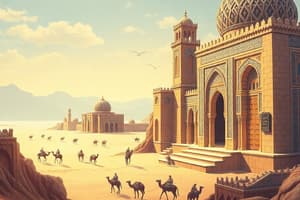Podcast
Questions and Answers
What has been the recent trend among some social media accounts in Saudi Arabia?
What has been the recent trend among some social media accounts in Saudi Arabia?
- Promoting cultural heritage and traditions
- Promoting the return of ancient Arabian, pre-Islamic deities (correct)
- Promoting modernization and religious identity
- Promoting the kingdom’s nationalistic identity
Which goddess was specifically mentioned in the post, along with imitated rituals surrounding the statue?
Which goddess was specifically mentioned in the post, along with imitated rituals surrounding the statue?
- Al-Lat
- Allah
- Manat
- Al-Uzza (correct)
What did the user claim about the connection of Saudi Arabians with their past?
What did the user claim about the connection of Saudi Arabians with their past?
- That only Muslims are deeply connected with their past
- That there is no connection with the past
- That citizens are deeply connected with their past, regardless of being Muslims or not (correct)
- That the past should be forgotten
According to the user, why does the Saudi government give importance to the ancient Arabian gods?
According to the user, why does the Saudi government give importance to the ancient Arabian gods?
What did the user refer to as 'symbols of female empowerment'?
What did the user refer to as 'symbols of female empowerment'?
What is the main concern among religious Saudis and other Muslims regarding the recent promotion of ancient Arabian deities?
What is the main concern among religious Saudis and other Muslims regarding the recent promotion of ancient Arabian deities?
What did the user assert about the connection of Saudi Arabians with their past?
What did the user assert about the connection of Saudi Arabians with their past?
What was the user's opinion regarding the Saudi government's treatment of ancient Arabian gods?
What was the user's opinion regarding the Saudi government's treatment of ancient Arabian gods?
According to the user, what is the significance of the three main goddesses of the ancient pre-Islamic polytheistic pantheon – Al-Lat, Manat, and Al-Uzza?
According to the user, what is the significance of the three main goddesses of the ancient pre-Islamic polytheistic pantheon – Al-Lat, Manat, and Al-Uzza?
What was the primary objective of the social media accounts promoting the return of ancient Arabian deities?
What was the primary objective of the social media accounts promoting the return of ancient Arabian deities?
Flashcards are hidden until you start studying
Study Notes
Trend among Social Media Accounts in Saudi Arabia
- Some social media accounts in Saudi Arabia have recently promoted ancient Arabian deities, specifically the goddess Al-Lat.
- The promotion involves imitated rituals surrounding the statue of the goddess.
Connection of Saudi Arabians with their Past
- The user claims that Saudi Arabians have lost connection with their past, and this promotion is an attempt to reconnect with their heritage.
- The user asserts that the Saudi government gives importance to ancient Arabian gods because they serve as a connection to the country's pre-Islamic past.
Significance of Goddesses
- The three main goddesses of the ancient pre-Islamic polytheistic pantheon – Al-Lat, Manat, and Al-Uzza – are symbols of female empowerment.
- The user believes that these goddesses hold significant importance in understanding the country's cultural heritage.
Concerns among Religious Saudis and Muslims
- The main concern among religious Saudis and other Muslims is that the promotion of ancient Arabian deities may lead to a revival of polytheistic beliefs and practices.
Objectives of Social Media Accounts
- The primary objective of the social media accounts promoting the return of ancient Arabian deities is to reconnect Saudi Arabians with their pre-Islamic past and cultural heritage.
Studying That Suits You
Use AI to generate personalized quizzes and flashcards to suit your learning preferences.




